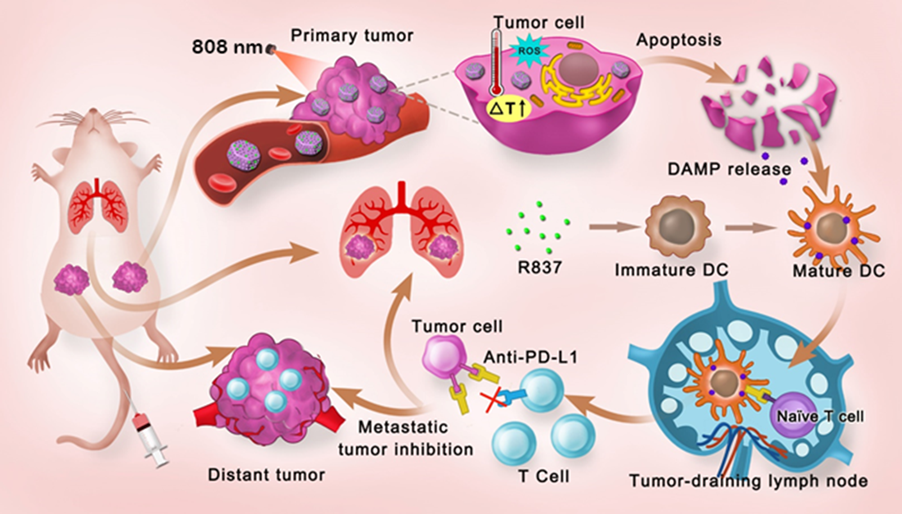Cancer immunotherapy, a treatment modality against tumor growth and metastasis by stimulating host immune responses, has made great progress over the past few years, but still faces challenges such as low therapeutic responses and immune-related adverse effects. Therefore, integrating immunotherapy with various therapeutic modalities has attracted substantial attention. Phototherapy, including photodynamic therapy (PDT) and photothermal therapy (PTT), is a less invasive treatment compared with chemotherapy. To be specific, PDT and PTT-induced immunogenic cell death (ICD) can release tumor-associated antigens and damage-associated molecular patterns, stimulating an immune response.
Photo-immunotherapy, the combination of phototherapy and immunotherapy, can effectively enhance treatment effectiveness compared with a single treatment modality. Increasing studies have reported that a variety of nanosystems as photosensitizers have been used in photo-immunotherapy. However, most of these nanosystems use only a single PDT or PTT model to induce a limited immune response, so it is difficult to break through the immunosuppressive barrier of the tumor microenvironment (TME), and the initiation of an immune response is significantly hindered. Up to now, the multifunctional photo-immune system is still in its infancy. There has been no relevant report on PDT combined with PTT, further integrating toll-like receptors (TLRs) to stimulate the immune response. Hence, the development of a multifunctional and safe photo-immunotherapy system for efficient tumor treatment is urgently needed.
Recently, DONG Wenfei's group from the Suzhou Institute of Biomedical Engineering and Technology of CAS, has developed a multifunctional nanoplatform based on mesoporous hexagonal core-shell zinc porphyrin-silica nanoparticles (MPSNs) loaded with R837 (a toll-like receptor-7 agonist), which can be used to integrate PDT, PTT, and tumor-specific immunotherapy for breast cancer. MPSNs with ZnP as the core and a mesoporous silica framework as the shell can effectively generate singlet oxygen and convert photons to heat with a single light source. Meanwhile, the excellent mesoporous structure of the silica shell can facilitate efficient R837 loading. Consequently, the therapeutic strategy based on MPSNs@R837 not only eradicated primary tumors via phototherapy modalities (PDT and PTT), but also effectively inhibited distant metastasis due to the strong immune response triggered by the two-way mechanistic interaction.
The research results entitled "Light-triggered multifunctional nanoplatform for efficient cancer photo-immunotherapy" have been published in the Journal of Nanobiotechnology (IF: 10.435). Dr. YUE Juan is the first author of the paper, and Prof. DONG Wenfei and Prof. MEI Qian are the co-corresponding authors. The research was supported by the National Key R&D Program of China (2020YFC2004500) and other funds.

Figure 1. Schematic diagram of nanomaterials for photoimmunotherapy of breast cancer. (Image by SIBET)
Contact
XIAO Xintong
Suzhou Institute of Biomedical Engineering and Technology, Chinese Academy of Sciences (http://www.sibet.cas.cn/)
Phone: 86-512-69588013
E-mail: xiaoxt@sibet.ac.cn